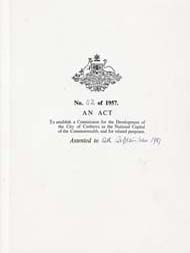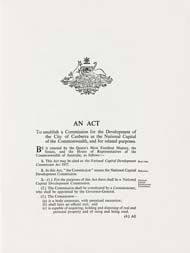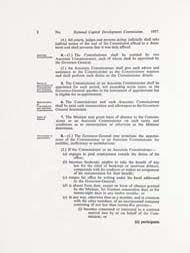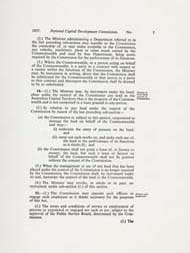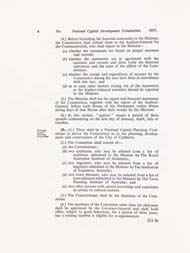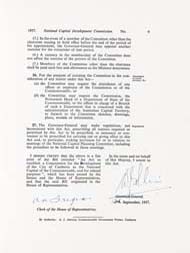

National Capital Development Commission Act 1957 (Cth)
Significance
This document, enacted on 12 September 1957, established a National Capital Development Commission to complete the establishment of Canberra as the seat of government.The Act provided for a coordinated body charged with shaping the environment in which people live, work and experience Australia’s national capital. It thus had the effect of shaping civil society through its setting, rather than through its laws.
History
From 1913 until 1920, Walter Burley Griffin led the design and planning of Canberra. After his dismissal a Federal Capital Advisory Committee was responsible until 1925 when the Federal Capital Commission was established. Under Chief Commissioner Sir John Butters, the Commission was responsible for planning and construction for five key years in which the transfer of the seat of government from Melbourne to the new national capital was achieved. It had taken more than twenty years to implement the intention expressed in the Commonwealth of Australia Constitution Act 1900.An advisory body, the National Capital Planning and Development Committee, operated from 1938 until 1957, when the government of Prime Minister Robert Menzies developed a policy to continue the unfinished work of building the national capital.
This Act was the key instrument for the successful implementation of that policy. From 1958 until 1989 the National Capital Development Commission was responsible for the planning, construction and urban development of Canberra. The Commission completed the transfer of Commonwealth government agencies and staff from Melbourne to the national capital, commenced in the 1920s.
The first Commissioner, Sir John Overall, was in charge until 1972. Implementing Walter Burley Griffin’s central lake scheme was the first task undertaken by the National Capital Development Commission, and construction of Lake Burley Griffin was completed in 1964.
Major buildings and monuments were constructed by the Commission and under ‘the Y-Plan’ the development of the national capital was decentralised with the development of four areas, Woden, Belconnen, Tuggeranong and Gungahlin. During the thirty years of the National Capital Development Commission Canberra’s population grew from 40,000 to 300,000.
The National Capital Development Commission was abolished the year after the ACT (Self-Government) Act 1988, with most functions and staff transferred to the ACT government. A new National Capital Authority was established for an ongoing Commonwealth role in the development of the national capital.
Sources
Atkins, Ruth, The Government of the Australian Capital Territory, University of Queensland Press, St Lucia, 1978.
Sparke, Eric, Canberra 1954–1980, Australian Government Printing Service, Canberra, 1988.
Description
| Long Title: | An Act to establish a Commission for the Development of the City of Canberra as the National Capital of the Commonwealth, and for related purposes (Act 42 of 1957) |
| No. of pages: | Cover + 10 pages |
| Medium: | Paper |
| Measurements: | 28 x 21.5 cm |
| Provenance: | House of Representatives |
| Features: | The Assent signature of the Governor-General William Slim on page 9 – and an error corrected by hand on the same page |
| Location & Copyright: | National Archives of Australia |
| Reference: | NAA: A1559, 1957/42 |
